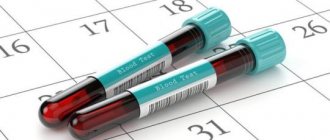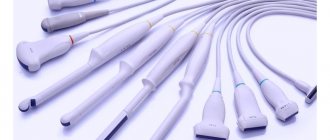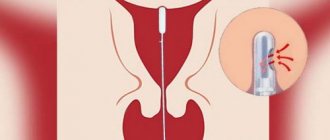Ultrasound of the mammary glands and menstruation, it would seem that what can connect these definitions? Menstruation is a natural physiological phenomenon, normal for a healthy female body. Ultrasound refers to medical research performed using a special device. However, every medical specialist knows that on what days of a woman’s monthly cycle a diagnostic ultrasound examination is performed determines how accurate the results will be. This is especially true for ultrasound of the mammary glands, since a correctly chosen period can clarify many situations related to the health of this organ.
Is it possible to do an ultrasound after menstruation?
As a rule, an ultrasound examination of the breast should be done from the 4th to the 14th day of the menstrual cycle, preferably on the first day after menstruation. It is during this period that the female breast is better visible, which makes it possible to notice any pathological changes in the gland at an early stage of development. This period is of particular importance for identifying tumors of a benign or malignant nature, since the choice of methods for further treatment largely depends on the early diagnosis of these diseases.
Indications and contraindications: is it possible to do an ultrasound during menstruation?
Ultrasound can be not only a component of a comprehensive medical examination or treatment, but also an urgent diagnostic procedure. But there are types of studies for which it is important for the patient to choose a specific day of the cycle. Is it possible to do an ultrasound during menstruation? What if an ultrasound needs to be done urgently? Almost every woman has at least once had to think about this delicate issue. The answer lies in the details, or more precisely, in the type of examination.
What can be examined at any time?
If we are talking about a procedure in a good clinic with a trusted specialist (or a private clinic in a small town), then an appointment for an ultrasound scan may be offered only after a few days, or even weeks. This does not make it possible to accurately compare the desired cycle date and the ultrasound appointment date. The patient is faced with a choice: to postpone the procedure to another time or to go through it calmly?
The day of the cycle has almost no effect on the diagnosis of some body systems. For example, the kidneys, liver, thyroid gland, cardiovascular system and joints can be examined at absolutely any time during the menstrual cycle.
Is it possible to combine?
However, to study the organs located in the pelvis, you need to choose a special day. Similar recommendations are given for breast ultrasound. Breast ultrasound is best done at the beginning of the cycle, preferably immediately after menstruation.
But the choice of time for pelvic sonography is directly dependent on the reasons for referral for such a diagnosis. If you need to confirm or refute the presence of endometriosis, then ultrasound is recommended to be done in the second part of the cycle. However, if you need to identify a cyst or tumor, then it is optimal to diagnose it at the beginning of the cycle.
In order to assess the condition of the ovaries or diagnose fibroids, echographic studies are carried out twice - immediately after the end of women's days and at the end of the cycle.
When is it better to refuse an ultrasound?
There is a list of special indications that allow you to do a pelvic ultrasound, regardless of the time of the cycle (even during the period of the heaviest bleeding). Such indications include complications after surgery or abortion, inflammation of the appendages, etc. And here doctors are unanimous: ultrasound during menstruation is allowed only in such emergency cases, all other indications allow you to postpone diagnosis for 3-5 days.
Doctors name a number of reasons why performing an ultrasound during menstruation is undesirable:
- The accumulation of blood and its clots in the uterine cavity, which prevents a detailed examination and may interfere with the diagnosis of certain pathologies.
- If bleeding occurs, it is not always possible to see small formations (cysts, tumors and polyps) on the screen. This can lead to misdiagnosis and progression of the disease.
- During menstruation, it is impossible to correctly determine the thickness and condition of the endometrial layer, that is, the mucous membrane lining the uterus. This indicator is key in determining a number of specific diseases, such as endometritis and endometriosis, hormonal disorders and chronic infectious processes.
And just an ultrasound during menstruation cannot be called comfortable or convenient. After all, organs located in the pelvis are usually scanned using a vaginal sensor, which causes embarrassment and discomfort for the patient. Discomfort is possible both psychological (from the presence of blood discharge) and physiological (many women do not feel well these days, and placement of the sensor in the vagina may be accompanied by minor pain).
When is it prescribed?
If you urgently need to undergo an ultrasound scan of the pelvis, the doctor will give a referral for the procedure immediately, regardless of the day of its cycle. However, it happens that an ultrasound must be performed precisely in the initial period of the cycle. This may be necessary to clarify a previously made diagnosis, or to form a complete picture of a comprehensive examination of the body.
When is menstruation not a problem?
- With significant blood loss during menstruation, which can become a sign of serious diseases. Therefore, in case of heavy bleeding, the endometrium should be examined during menstruation.
- If the doctor suspects myomatous formations, nodes, polyps or endometrial hyperplasia. At the same time, it is important not only to conduct an ultrasound in the initial period of the cycle, but also to choose for this from 1 to 3 days from the beginning of menstruation.
- If you need to clarify the type of cyst. Very small cysts (up to 1 cm in size) are convenient to consider only during the first time of the cycle, because over time they become thicker, which makes their differentiation difficult.
- When determining ovulation and examining the follicle. At the same time, ultrasound is performed repeatedly from days 1 to 15 of the cycle and becomes part of the program for treating infertility and identifying its causes.
Abdominal examination
The effectiveness and accuracy of most types of ultrasound examinations do not depend on the frequency of the female cycle - this can be seen even by a non-specialist.
However, the study of the abdominal organs also has its own nuances.
The fact is that the gastrointestinal tract is located next to the uterus and appendages, so patients have doubts: will the onset of menstruation affect the information content of abdominal ultrasound?
Reference! Doctors answer unequivocally: menstruation is not a contraindication to sonography of the retroperitoneal organs; this procedure is successfully performed at any time of the cycle and will be equally informative both on the first and last day of menstruation.
If you think that you need an abdominal ultrasound, or your attending physician thinks so, then you should not focus on menstruation, it is better to focus on the health of the organs being examined. So, you need to undergo an abdominal ultrasound if you have one of the following symptoms:
- bitterness and nausea in the mouth, as well as their intensification after eating;
- discomfort and pain under the right rib;
- feeling of heaviness after any meal;
- gas formation, bloating, etc.
During an abdominal ultrasound, the doctor examines the kidneys and liver, pancreas and spleen, as well as the gallbladder. The examination method is transabdominal (not transvaginal!), that is, through the anterior abdominal wall. Little preparation is required from the patient:
- filling the bladder before the procedure;
- a special three-day diet with the exclusion of foods that cause flatulence;
- cleansed intestines.
Examination of the mammary glands
To conduct an ultrasound of the mammary glands, the best time is considered to be days 5-8 of the cycle, but the study can be carried out from days 4 to 14 from the start of menstruation. This period will provide the opportunity to obtain the most accurate and correct diagnostic results.
Reference! During menstruation, the mammary glands are characterized by changes that make it possible to examine the development of various parts of the glandular tissue in dynamics. This gives a chance to more accurately establish a diagnosis if there is suspicion of the development of the disease, and prescribe the correct treatment.
When exactly is a breast ultrasound performed during menstruation? The study is prescribed if the patient has symptoms such as:
- redness or swelling of areas of the breast;
- the presence of purulent discharge from one or both nipples;
- any changes in the gland that lead to deterioration in health (increase in body temperature, nausea, drowsiness, lethargy and chronic fatigue);
- cystic formations (examination is carried out to determine their nature, especially if the cyst changes size);
- postpartum mastitis;
- abnormal mammography results;
- selection of hormonal contraceptives;
- injuries to the chest or breast tissue;
- functional disorders in the ovaries and other hormonal-dependent gynecological pathologies;
- postoperative examination of the breast condition (both after implantation surgery and after other surgical interventions);
Preparation
If the attending physician considers that the patient needs a referral for a pelvic ultrasound during her period, then special preparation is needed.
Important! Before the internal ultrasound, empty the intestines and empty the bladder.
If the study is scheduled in advance, and there is time to prepare, then a few days before it you need to change your diet and give preference to dietary nutrition that prevents flatulence. If constipation occurs, it is better to do an enema the day before.
At home, before going for an ultrasound, you need to swim and take with you a baby oilcloth or waterproof diaper.
Important! Do not use a syringe before an ultrasound! During menstruation, the cervix is slightly open and this may be enough for various types of infections to enter the uterine cavity.
The process of douching will not help maintain hygiene, but it can become a factor provoking illness.
Conclusion
The ultrasound diagnostic procedure will not affect a woman’s health during her period in any way; it will not cause pain or increased bleeding. However, the results of some studies may be distorted on menstrual days.
Therefore, it is better to discuss the specifics of ultrasound with the attending physician prescribing the procedure. Only he can say with confidence whether it is worth carrying out sonography on a certain day or whether it can be rescheduled without harming the accuracy of the diagnosis.
medigid.com
When is it better to do it: before or after?
In order for the results of an ultrasound examination to be more accurate and allow for a more detailed examination of the slightest deviations in the structure of the mammary gland, it is important that at the time of the examination there is no increase in hormonal release. It is known that before each menstruation, changes occur in the breasts; they swell and, as it were, begin to prepare for a possible pregnancy. At this moment, the mammary glands increase in size and their sensitivity increases. During this period of hormonal changes, small details may not be noticed during the examination, so gynecologists recommend conducting a breast examination after menstruation.
In the first phase of the menstrual cycle, the milk ducts are in the most constricted state. At this moment, ultrasound can easily detect the appearance of compactions that dilate the ducts, which is not typical for this particular phase. Enlarged areas of the ducts become very noticeable and can be easily detected, even if the tumor does not exceed 0.5 cm in size.
The second phase of the menstrual cycle is characterized by dilated milk ducts and it is very difficult to detect any changes in them even with the help of special equipment.
Indications for ultrasound diagnostics of the breast
Doctors recommend an ultrasound of the mammary glands for all women over 30 years of age. The procedure is prescribed to them for preventive purposes and is carried out annually. For patients over 40 years of age, it is advisable to conduct examinations 2 times more often. There are also situations when an ultrasound examination is urgently needed.
Such cases include:
- asymmetrical shape or difference in size of the mammary glands;
- clear, cloudy or colored discharge not associated with lactation and pregnancy;
- enlarged axillary lymph nodes;
- retraction (retraction) of the nipple;
- change in color, structure, shape of the halo around the nipple, formation of scales, ulcers and other pathological formations on it.
Urgently or routinely, ultrasound examination of the breast is prescribed to women who have been diagnosed with:
- injuries of the mammary glands, which may be complicated by the formation of a tumor;
- hormonal disorders;
- polycystic ovary syndrome;
- inflammatory processes in the mammary gland (mastitis);
- neoplasms and tissue compactions detected during a routine examination by palpation, or upon independent discovery.
Ultrasound diagnostics is also indicated for women under the age of 30 when selecting hormonal contraceptives after breast augmentation with implants. Another common reason for needing a breast ultrasound is gynecomastia in men.
When to do an ultrasound of the mammary glands after menstruation
To the question “how many days after menstruation is an ultrasound of the mammary glands done”, there is a clear answer. The best period for carrying out such a procedure is in the first days after menstruation, from the 4th to the 14th day of the cycle. Breast examination these days is carried out for the following indications:
- upon examination at a gynecologist's appointment, an increase in axillary lymph nodes was detected;
- changes in the skin on the mammary gland in the form of peeling and retracted areas;
- pain in the mammary glands, or in one of them;
- raising the arms reveals pitting and unevenness in the chest.
A little about the research
The ultrasound examination method itself appeared about half a century ago. Today it is widely used in diagnostics.
Ultrasound of the mammary glands is a fairly simple procedure that should be performed by an experienced specialist.
The patient who came for the examination should take off her clothes to the waist and lie on the couch with her hands behind her head so that the specialist can examine both the breast and the lymph nodes near it. The ultrasound doctor applies a little special gel to the chest so that the waves coming from the device pass better through the body tissues. Next, the doctor moves a special device over the area of the mammary glands and looks at a picture on the screen in which the internal tissues are visible. Based on these images, he evaluates the structure of the glands, their size and contour, ducts and lumens, the presence of unusual seals or protrusions, as well as neoplasms.
A gynecologist, mammologist or oncologist can correctly assess the condition of the mammary glands using ultrasound.
Ultrasound of the mammary glands during menstruation
The timing of a breast examination depends largely on the current situation. Sometimes diagnosis needs to be carried out as soon as possible, without waiting for favorable days in a woman’s monthly cycle. As practice has shown, it is advisable to immediately perform an ultrasound examination of the mammary glands during menstruation in the following cases:
- if there is severe swelling or areas of hyperemia on the skin of the mammary glands;
- presumptive formation of a cyst in order to study its contents, whether it contains fluid or a cyst with a dense, homogeneous filling;
- in order to monitor the dynamics of the increase or decrease of the cyst;
- determination of the nature and nature of papillomas located on the chest;
- if the mammogram results showed an atypical condition of the mammary gland, there is a need to determine the nature of the detected neoplasm (cyst or tumor).
Also, the procedure for examining the mammary glands during menstruation using ultrasound is often done in atypical situations that exclude changes directly in them, namely:
- after surgery with the installation of breast implants;
- suspicion of the development of mastitis after childbirth;
- when choosing a hormonal contraceptive;
- after trauma to the chest in the chest location;
- in the event of gynecological disorders caused by dysfunction in the ovaries.
It is not advisable to conduct a breast examination to detect a tumor in the second phase of the menstrual cycle, since at this time the ducts in it are dilated and do not allow obtaining true results. Therefore, as a rule, if there is a suspicion of existing tumors in the mammary gland, whether they are malignant or benign, an ultrasound is performed at the very beginning of the menstrual cycle, preferably on the first day of menstruation.
Calculating the best days
When to do an ultrasound of the mammary glands after menstruation depends on the length of the cycle. The optimal period of the cycle is before ovulation. And in this period the best time is when:
- stromal tissue is quite dense, which makes it possible to examine all the nuances, including neoplasms;
- milk ducts are narrowed;
- the alveoli have a maximally reduced size.
If a woman’s cycle is 28 days, then ovulation occurs approximately on the 12th - 14th day. That is, it is advisable to conduct the examination from 5 to 11 days. With a shorter cycle, the time period in which breast ultrasound will give the most accurate results decreases. After all, ovulation will occur earlier. If the menstrual period is longer than 28 days, there will be more time to examine the mammary glands using ultrasound. But in each case it lasts from the last day of menstruation to several days before ovulation occurs in the middle of the cycle. Later, the mammary glands, under the influence of hormones, prepare for a possible pregnancy. That is, the blood supply to the alveoli increases, swelling appears. Enlargement of breast tissue will not allow you to see small but important changes for making a correct diagnosis.
There are some peculiarities in determining the timing of the procedure:
- Sometimes specialists prescribe ultrasound in the second half of the menstrual period. It will be most useful for collecting information for hormonal disorders. But in this case, the procedure is carried out shortly after ovulation, without waiting for the woman to experience PMS.
- If the cycle is unstable, which happens with some gynecological pathologies that require breast examination, a blood test for hormones may be needed (estrogen levels are especially important). This is the only way to accurately calculate the speed of ovulation, and therefore the optimal time for examination.
- Pregnant and lactating women, as well as those who have entered the age of menopause, do not have to worry about what day of their period a breast ultrasound is performed. For known reasons, the two categories mentioned do not have menstruation. But when breastfeeding, your period may come. And yet, due to lactation, breast tissue hardly changes at different periods of the cycle: the ducts are dilated, the alveoli actively produce nutrition for the baby. Therefore, on what day a specialist will examine the mammary glands of a nursing mother does not matter.
We recommend reading the article about mammography during menstruation. From it you will learn about the timing of the examination, the methodology for conducting it, the radiation dose received, as well as the recommended days of the cycle.
Ultrasound of the mammary glands before critical days
In cases where it is necessary to determine the nature of changes that have occurred due to hormonal disorders, ultrasound of the mammary glands is done in the middle of the menstrual cycle, in its second phase. Also, you should not postpone a visit to the gynecologist or, even better, contact a mammologist if symptoms that are unusual before occur. If you experience chest pain, burning, or swelling, it is better to consult a specialist immediately. An ultrasound scan of the mammary glands before menstruation is also necessary if lumps, asymmetrically located nipples, or discharge from them are detected.
Is it true that abortion increases your chances of developing breast cancer?
Abortion causes dramatic hormonal changes in a woman's body, and since breast cancer is often caused by hormonal imbalances, it can be concluded that abortion causes breast cancer. However, this is a false conclusion: the American College of Obstetricians and Gynecologists and the National Cancer Institute have been conducting research since 2003 and trying to establish a relationship between
How is an abortion performed? deliberate termination of pregnancy and oncopathology of the mammary glands. In 2021, the organizations came to the conclusion: there is no such connection.
In addition, the American College of Obstetricians and Gynecologists, together with the National Cancer Institute, has established a link between miscarriage (spontaneous abortion) and breast cancer. But studies have also shown that there is no cause-and-effect relationship between poor breast health and spontaneous abortion.
Features of ultrasound for mastopathy
One of the main methods for diagnosing mastopathy is ultrasound, which is performed in the first half of the menstrual cycle. The reason for the study is most often the occurrence of a painful symptom. Most often, when patients complain of pain in the gland, it is possible to determine the presence of this particular disease - fibrocystic mastopathy. The result obtained after diagnosis on ultrasound reveals the existing compaction in the connective tissue, a slight expansion of the milk ducts and small cysts. However, the changes that occur in the mammary glands of different women are individual and may differ in nature.
Ultrasound allows you to confirm the existing pathological process and, after a final diagnosis, decide on treatment. Also, this kind of diagnosis will make it possible to monitor the effectiveness of the treatment route used for mastopathy and identify indications for surgical intervention.
There are no special features in conducting the examination itself for mastopathy; it is a harmless and painless simple procedure that consists of the usual steps. A special gel is applied to the chest area, after which the structure of the gland is studied using a moving sensor. Based on the results of the study, a conclusion is drawn, which, if necessary, can be written to disk.
To diagnose mastopathy, an ultrasound procedure is necessary, as it allows you to monitor the effectiveness of treatment. Ultrasound diagnostics does not cause any harm to health, so it can be used even for mastopathy in pregnant women and during breastfeeding. This is its main difference from mammography, which involves some exposure to radiation to the body. Therefore, how often an ultrasound will be performed is determined by the attending physician, based on the patient’s individual indicators.
Despite all the positive aspects of ultrasound, this procedure has some peculiarities. The reliability of the result is affected by what day of the menstrual cycle the breast examination is performed. It is recommended to perform it from 4 to 14 days of the cycle, when it is possible to obtain more accurate results. At a later stage, changes characteristic before ovulation begin to occur in the tissues of the mammary glands, and its tissues transmit the signals of the apparatus less well.
What symptoms require immediate consultation with a mammologist?
Changes in the breasts cannot be ignored: it may seem that swelling or pain in the mammary glands is a temporary phenomenon due to the nature of menstruation. However, these changes in the mammary glands may indicate more serious disorders. Early detection of breast pathology practically guarantees a cure and a favorable outcome of the disease. Be sure to make an appointment with a mammologist if:
- there were regular aching or sharp pains in the mammary glands;
- the breasts have noticeably changed in size, or the skin around the nipples has acquired a different color;
- During a self-examination of the breast, a lump, tumor or nodes were discovered;
- the shape or color of the nipples has changed, crusts have appeared on them or the nipples have begun to peel off;
- nipples retracted;
- fluid mixed with pus or blood is released from the nipples.
Don't wait for the problem to go away on its own - it may not go away and will get worse. Contact a mammologist, he will examine your breasts and assess their condition.
Ultrasound for fibroadenoma
Fibroadenoma is one of the most common tumors that form in breast tissue and are benign in nature. Most often it occurs in young women and represents disturbances in the development of the milk lobules. To diagnose this disease, in addition to histological analysis, mammography and ultrasound are used. But it is ultrasound examination that makes it possible to determine what the tumor consists of, whether it is a hollow cyst or filled with fluid.
Ultrasound allows you to determine the effect of fibroadenoma on nearby tissues, whether it compresses the milk ducts or is simply located around them. On the monitor screen, fibroadenoma looks like a dense, clearly defined, slow-growing tumor that moves freely under the fingers. This is one of its main differences from tumors of a malignant nature, which do not have clear boundaries and are immobile.
Examination of the breast in the presence of fibroadenoma is of great importance, as it allows you to monitor the dynamics of changes in its character.
Diagnostics using ultrasound plays a big role in being able to determine the initial stage of the disease. Not least important in the final diagnosis is the timing of the examination relative to the menstrual cycle. But you also need to firmly understand that if critical situations arise with the identification of pathological conditions in the mammary glands, you must immediately consult with specialists within 24 hours.
Can a blow to the chest cause breast cancer?
The development of breast cancer from a blow to the chest is a common misconception. This myth is based on the idea that if damage to the breast leads to the appearance of a lump or lump in the breast tissue, then a malignant tumor occurs. However, there is no evidence or research that suggests that a blow to the chest can lead to breast cancer.
In fact, a lump after a mammary gland injury is a bruise deep in the tissue that forms as a result of a hematoma. There is no connection between trauma and the formation of oncological pathology.
However, a blow to the bust can lead to other complications, such as damage to the vessels that allow blood to flow in and out, damage to the breast ducts, bleeding and chest pain. But these complications occur rarely. If there is a blow to the breast, you should consult a mammologist. For diagnosis, he will prescribe an ultrasound or mammogram.
Is it possible to do an ultrasound during menstruation of the pelvic organs, breasts, thyroid gland, kidneys?
The doctor has prescribed you an ultrasound examination of the abdominal cavity (or, simply put, ultrasound). And this has to happen, the day before the procedure your period begins. Is it worth doing an ultrasound during menstruation? In response to this question, compassionate friends vying with each other begin to tell scary stories that happened to their friends in the doctor’s office. My mother tries to dissuade me from conducting a diagnosis, and my husband shrugs his shoulders in bewilderment. To resolve all doubts, let's look at this issue in detail.
Before the ultrasound procedure, you need to find out whether there are inappropriate days for diagnosis
When there are no restrictions
Let's put all the dots right away. Restrictions on diagnostics using ultrasound during menstruation apply only to examination of the female reproductive organs:
- ovaries;
- uterus;
- appendages;
- mammary glands.
It is not advisable to perform an ultrasound of the pelvic organs during menstruation.
Therefore, if the doctor has directed you to examine other abdominal organs, then during your period you can safely go for the procedure. Critical days will have absolutely no effect on the study:
- thyroid gland;
- kidney;
- Bladder;
- liver.
I would immediately like to dispel women’s fears that ultrasound increases bleeding in the pelvic area. The procedure is absolutely harmless to the body and does not lead to a deterioration in the condition of the liver, kidneys, or thyroid gland.
Why does menstruation skew results?
Experts do not recommend doing a pelvic ultrasound during menstruation, because not only blood, but also blood clots accumulate in the uterine cavity. The uterine mucosa is shed unevenly, and pathology or neoplasm may not be seen. In such conditions, it is difficult for a specialist to assess the endometrium of the uterus and its thickness. But it is the study of the endometrium that helps to draw a conclusion about the causes of the disease.
Gynecologists sometimes recommend that their patients undergo a transvaginal pelvic ultrasound. The specialist will perform the procedure using a special vaginal sensor, which is inserted directly into the vagina. The results of the examination of the abdominal organs are displayed on the monitor.
To diagnose certain diseases, the doctor prescribes a transvaginal examination
Agree that vaginal pelvic examination is inconvenient to perform during menstruation. Discharge makes the procedure unhygienic and unpleasant for the woman herself, creating psychological discomfort for her. Therefore, performing a transvaginal ultrasound during menstruation is not recommended. It is better to postpone it until a later period.
When you really need it
Doctors say that it is best to carry out diagnosis between 8 and 11 days of the menstrual cycle. At this time, optimal conditions are created for examining the abdominal cavity: the new uterine mucosa has already been formed, but at the same time it is not yet very thickened. Therefore, all changes in the structure can be clearly seen.
But in medical practice there are often situations when emergency ultrasound diagnostics can save a woman’s health, and sometimes life. For example, if there is a threat of miscarriage. Bleeding does not prevent detection of the fetus in the uterus, so the degree of its attachment to the uterine wall can be assessed. Based on the results, doctors prescribe emergency therapy to maintain pregnancy.
An ultrasound scan during menstruation cannot be avoided in case of pathologies that can only be diagnosed in the first days of the cycle. A pelvic examination during menstruation is prescribed in the following cases:
- Follicle screening. The procedure is performed for the treatment of infertility and menstrual irregularities from days 1 to 15. By the way, the problem of infertility can develop due to malfunctions of the thyroid gland. Therefore, if you want to get pregnant, do not forget to check your thyroid gland.
- Hyperplasia, polyps, fibroids. An examination of the pelvic organs is carried out in the first three days of the menstrual cycle. Subsequently, the endometrium in the uterus thickens, which may affect the objectivity of the results.
- A cyst with a diameter of up to 1 cm. Tiny formations in the abdominal cavity are clearly visible only from days 1 to 5 of the cycle.
- Heavy periods. Using ultrasound, the doctor determines the condition and thickness of the endometrium of the uterus, pelvic organs, including the ovaries. Heavy periods may indicate problems with the thyroid gland. Therefore, it is advisable to do the diagnosis in combination with a study of the thyroid gland.
What about breasts?
Gynecologists recommend that women conduct a self-examination of the mammary glands every month. By examining the breast, you can identify various neoplasms at a very early stage, when the chances of a complete cure are high.
Every woman should take care of her own health
But the problem is often that not all mammary gland pathologies can be palpated. Therefore, breast diseases can quietly develop to a stage where doctors are powerless. New growths in the structure of the mammary glands can be examined using a special procedure called “mammography”.
All women (without exception!), starting from the age of 35, must undergo mammography annually. Using X-rays, a mammograph detects the presence in the breast of:
- neoplasms;
- cyst;
- calcifications.
During mammography, a puncture biopsy can be performed, i.e., material can be taken for laboratory examination of the tumor through a very thin puncture.
Women note that breast mammography is absolutely painless. Minor discomfort appears only at the moment of fixation of the mammary gland to take an image. The procedure takes about 20 minutes.
Doctors recommend doing mammography from days 5 to 14 of the menstrual cycle. This gap was not allocated in vain. A few days before and during your period, breast tissue becomes very sensitive and noticeably thickens.
Mammography will detect neoplasms at an early stage of appearance.
The effectiveness of ultrasound depends on many factors. As you can see, during menstruation there are both indications and contraindications for diagnostics. In any case, do not neglect consulting a doctor. He will expertly tell you about all the nuances and, perhaps, reschedule the procedure for a more appropriate time.
ladykrasotka.com











